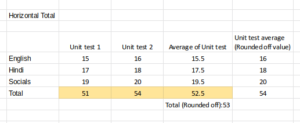There are two ways of calculating the total marks
1) Summing up the totals (Horizontal Total)
2) Summing up the constituents of the nodes (Vertical Total)
In case of rounding off decimal values, there is a difference in the marks of both the methods.
The example below will explain the difference.
Consider assessments Unit Test 1 and Unit test 2 with subjects English, Hindi and Social Science, and an assessment which calculates the average of Unit Test 1 and Unit Test 2.
According to the method of Horizontal Total, the total marks secured in the assessment Average of Unit Tests is equal to the average of the total marks secured in the individual assessments.

i.e. the average of unit test 1 and unit test 2: (51+54 )/2 = 52.5. Rounding it off to the next decimal makes it 53.
According to the method of Vertical Total, the total marks secured in the assessment Average of Unit Tests is equal to the sum of the average marks of the individual subjects.

Thus, according to the method of Horizontal Total, the total marks of a level is calculated by adding the marks secured in the level immediately below it.
According to the method of Vertical Total, the total marks of a level is calculated by adding the marks in 2 levels below that level.